Morpheus Space Scalable Thrusters
Technology Development
Morpheus Space Scalable Thrusters
Morpheus Space is an innovative new company seeking to revolutionize the nanosatellite industry by enhancing its capabilities and sustainability. To launch the company, the six founders built on their research experience from Technische Universität Dresden (TU Dresden), Germany, on electric propulsion for nanosatellite technology. 1) 2) 3)
Spinning out Morpheus Space GmbH from TU Dresden was the team’s final milestone in a 7-year R&D roadmap. They have successfully secured over €1 million in resources so far to set up production and launch products on the market, and are now looking to firmly establish the company in the space industry.
Morpheus Space’s Technology
Morpheus’ core technology is a modular electric propulsion system suitable for small satellites called the NanoFEEP (Nano Field Effect Electric Propulsion). This is a miniaturized ion thruster combined with a neutralizer (to avoid electrostatic charging of the satellite) and control components.
The NanoFEEP system is a very innovative propulsion technology that offers one of the best specifications available in the industry in three distinct categories: high efficiency (in terms of specific impulse delivered), low weight and long equipment lifetime.
Morpheus also develops bespoke thruster systems by combining multiple propulsion units in the MultiFEEP system. The combined system can be custom-designed to achieve complex and challenging 3D thrust profiles, across a wide thrust range, for difficult applications and complicated orbits.
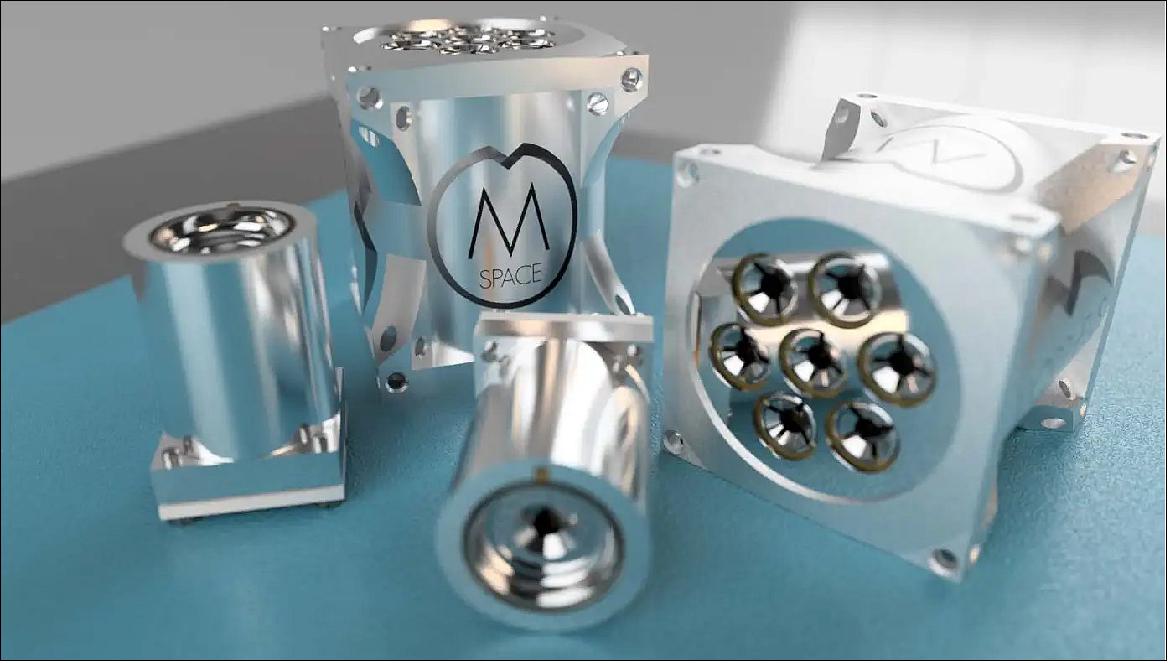
Fully Tested: On and Off Earth
In December of 2018 a CubeSat developed by Morpheus and a team at the University of Würzburg was launched into orbit.
The launch was part of the University Würzburg Experimental satellite-4 (UWE-4) mission designed to test and demonstrate the use of the NanoFEEP propulsion system, in a setup specifically designed to meet the exact size and power requirements of the CubeSat.
A few weeks ago the UWE-4 satellite sent a beacon message explaining that the system was successfully used saying: “Today, 26 February 2019 at 09:59:00 UTC, one of my NanoFEEP thrusters, developed by TU Dresden and Morpheus Space, was successfully ignited! This is the first time that a 1U CubeSat has activated an electric propulsion system in space!! Primary mission: accomplished! Time to celebrate ...:-)”
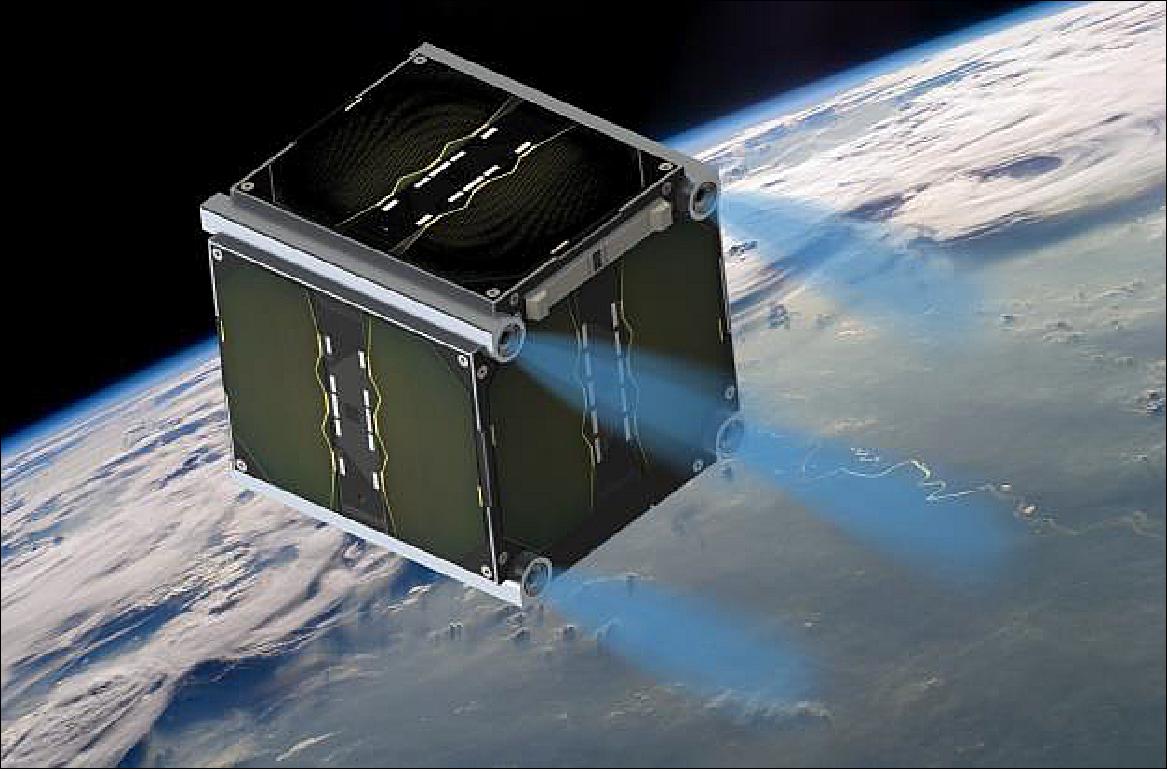
2019 and Beyond
The successful UWE-4 mission was a major stepping stone for the company, and the next stage in Morpheus’ ambitious plans. We spoke with Co-founder István Lörincz to find out a little more, who said: “Our plans for the rest of the year are to scale up production and equip as many satellites as possible with our systems.”
Alongside these objectives Morpheus is also trying to change the space industry’s approach to small satellite missions through its technology: “Our most important goal, which is also our mission statement, is to show the NewSpace industry that a sustainable approach to nanosatellite missions and constellations doesn’t just mean keeping the Low Earth Orbit clean by assuring a re-entry into the atmosphere,” said István.
“If the solutions for re-entry are taken into account early on in the design process of a space mission, new possibilities open up to optimize operations of small- to large-scale constellations, which leads in the end to better, smarter business models.”
“That is why we want to change the industry standard, in which the classical roles of customer and supplier are fundamentally disconnected. We strive for a relationship with our customers and partners, in which we take an active part in the design process of each mission. This way we can modify and optimize our systems to the mission and not the other way around, where the customer obtains an inflexible product and has to adapt the whole system to it. Our biggest achievement with respect to this aspect is the way we have developed our systems, which are modular and easily modifiable without having a negative impact upon our production throughput or lead time.”
Here at satsearch we believe that a dynamic and successful space industry will be built on the sort of forward-looking and collaborative initiatives that Morpheus is bringing to the market.
Space missions are complex and challenging, and the closer that all partners can work together, the more likely they are to succeed.
Developing Truly Agile Constellations
Morpheus’ innovative propulsion systems are also being combined with new data processing capabilities to bring some revolutionary new services to market. As István explains: “In order to motivate the NewSpace industry to adapt our philosophy of the customer-supplier relationship we are collaborating with AI research facilities to offer a service that allows a completely new approach to the operation and design of nanosatellite constellations.”
“We call it Agile Constellations, and this service is available to all of our customers who operate our propulsion systems on their satellites.”
Morpheus’ Agile Constellations system is an AI-driven platform that can efficiently identify the best possible way to organize a complete satellite constellation based on each satellite’s capabilities, in order to achieve the necessary points-of-interest objectives.
These objectives can range from fixed revisit frequencies (temporal resolution of observation) to orienting with respect to frequently changing or moving points-of-interest.
The service is designed to open up new business opportunities for established NewSpace companies and allow new, smaller constellations to maximize their potential without unnecessarily increasing in size.
But most of all it will increase NewSpace businesses’ flexibility, which is so crucial in this industry that is evolving at such a rapid pace.
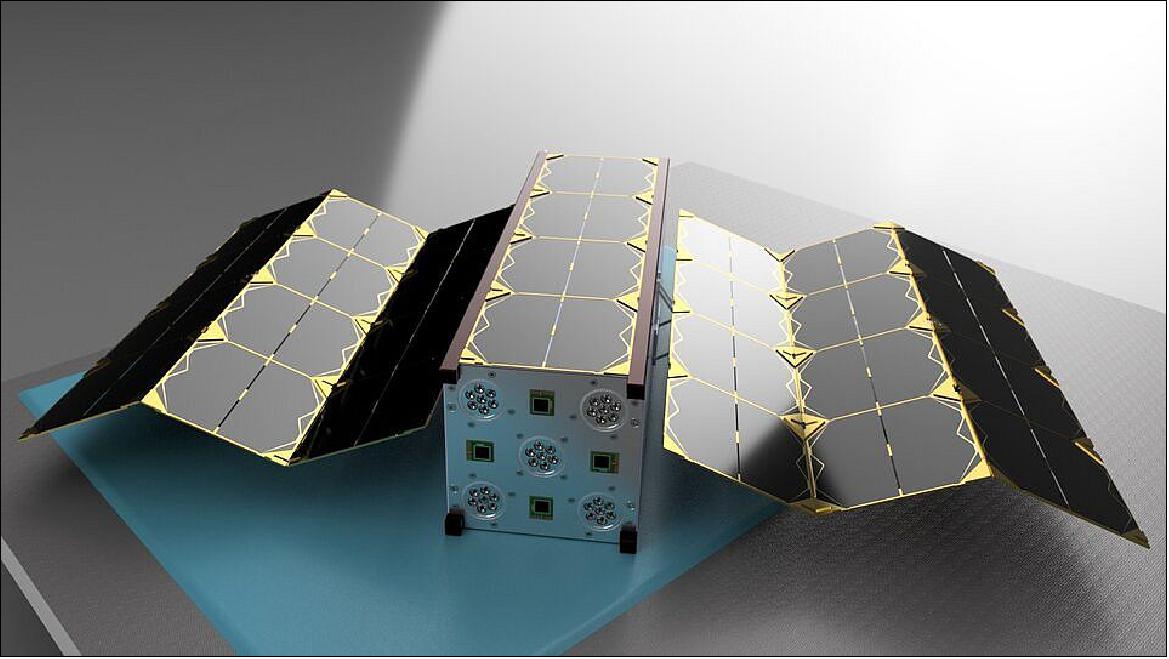
Morpheus Space will be able for the first time, to truly build up satellite networks that can be operated as one entity, opening up new disrupting business opportunities and models in the NewSpace industry (Ref. 3).
“A current and very serious problem in the space industry is the ever-growing space debris. To continue to use space in the future, the debris must be disposed of much faster as that is the case naturally,” explains István Lörincz, Morpheus Space CBO (Chief Business Officer).
“We, at Morpheus Space, have aligned our core values with those of the UN when we speak about a sustainable future in space and on Earth. Our technology can be used for this purpose.
“With NanoFEEP, a small CubeSat who would otherwise be in orbit for 25 years could be propelled back into the atmosphere within 2 years. With MultiFEEP, one can even dispose of a 6U CubeSat within 2 years, which would otherwise orbit for 1000 years as a space debris,” adds Daniel Bock.
“Morpheus Space supports sustainability in space and on Earth by opening up possibilities for the industry to optimize satellite operations.”
![Figure 4: The company team includes Daniel Bock (CEO), István Lörincz (CBO), Christian Schunk (CTO), Christian Boy (Head of Production), Philipp Laufer (Head of R&D) and Prof. Martin Tajmar (Advisor), [image of the Morpheus Space team at ESA Investment Forum]](https://eoportal.org/ftp/satellite-missions/m/Morpheus_151121/Morpheus_Auto4.jpeg)
Morpheus Space, which began life as a research project at the Dresden University of Technology, has accomplished a lot when it comes to propulsion in the short time since its official founding around a year and a half ago. The Dresden-based startup already has sent some of its thrusters to space, where they’re actually providing propulsion, and it’s working with a number of clients and potential clients, including NASA’s Jet Propulsion Laboratory. The startup also just wrapped up its participation in Techstars’ inaugural Starburst Space Program in LA.
NanoFEEP Modules: NanoFEEP is a miniaturized ion thruster that uses a special low-melting point alloy as propellant.
Dynamic Thrust Range (Maximum) | 1 - 20 µN (40 µN) |
Specific Impulse | 3000 to 8500 s |
Total System Power | 0.2 to 3 W |
Total System Mass (dry) | 160 g |
In order to prevent the electrostatic charging of the satellite, our systems employ an innovative neutralizer technology. The main function of this subsystem is to emit the same amount of electrons as the thruster is emitting positive ions. To make this as efficient as possible we use carbon nanotubes, which are applied on a silicon chip, allowing us to create a never before seen miniature size and efficiency.
Our electronics board generates, delivers and regulates the necessary high voltage of up to 12 kV for two thrusters and a neutralizer. It incorporates highly sophisticated monitoring solutions in order to prevent any possible malfunction of the system. We have also integrated countless fail-safe features into this tiny board, through which the system fulfills the high reliability standards setforth by the space industry.
Development Status
• November 12, 2021: NASA has awarded $90,000 each to seven entrepreneurial startup companies under its Entrepreneur’s Challenge program. The awards will advance new technology concepts ranging from novel materials with properties not found in nature to innovative technologies that will enable small satellite (SmallSat) science missions. 4)
- The following companies were selected as winners of the Entrepreneur’s Challenge:
a) Morpheus Space of Los Angeles, California
b) Multiscale Systems of Worcester, Massachusetts
c) Nebula Compute of San Diego, California
d) Niobium Microsystems of Dayton, Ohio
e) OAM Photonics of San Diego, California
f) Resilient Computing of Bozeman, Montana
g) Zephyr Computing of Oakland, California
- “We face audacious technical challenges to accomplish our NASA science goals,” said Florence Tan, acting Science Mission Directorate chief technologist at NASA Headquarters in Washington. “Entrepreneurs can bring a diversity of groundbreaking ideas, concepts, and innovations that are relevant to our science goals. We want to invest in breakthrough technologies that will lead to revolutionary science discoveries. This program is a wonderful way to keep those ideas coming into our technology development programs.”
- NASA partnered with Starburst Aerospace in San Francisco, California, to launch the Entrepreneur’s Challenge, which aims to engage U.S.-based entrepreneurs. The program seeks fresh ideas in technology that could advance the agency’s science goals to explore and understand the solar system and beyond. The challenge also seeks to increase the number of entrepreneurial companies participating in the agency’s technology portfolio.
- The technical focus areas for the 2021 Entrepreneur’s Challenge were:
1) SmallSat technologies including advanced sensors, high-speed electronic systems, and the capability to autonomously recognize science phenomena in space and respond as needed.
2) Sensors made of metamaterials – manufactured materials with properties not found in nature – to detect and observe their surroundings at dramatically reduced size, weight, power, and cost.
3) Instruments to detect biomarkers or that can determine evidence of habitability on ocean worlds.
- Administered by NASA’s Science Mission Directorate, the competition was conducted in two rounds. In the first, companies nationwide submitted 44 submissions. A NASA judging panel selected 10 companies from the three focus areas to each receive a $10,000 award. In the second, the participants refined their concepts, developed detailed white papers, and gave presentations to the same panel of judges. The panel selected seven of the companies from two of the focus areas to receive an additional $80,000 in prize funding.
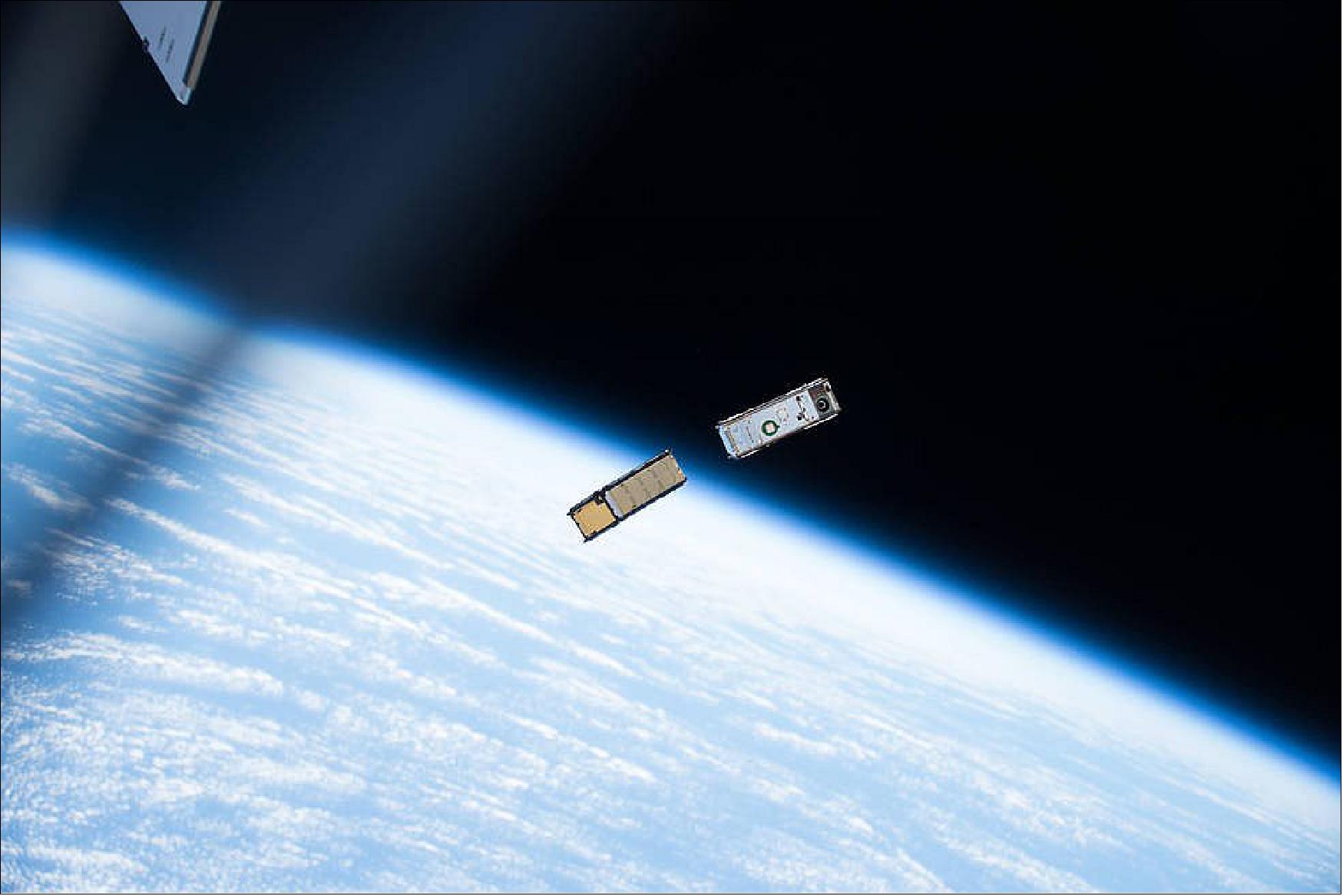
• November 12, 2021: Morpheus Space is going far beyond its roots as a German university spinoff with a series of announcements the company is releasing ahead of the Space Tech Expo next week in Bremen, Germany. 5)
Morpheus, a German propulsion startup that opened an office in Los Angeles earlier this year, unveiled a suite of products, called the Sphere ecosystem, that are designed to work together to reduce the cost and complexity of satellite constellation operations.
The Sphere line includes a new nontoxic propellant, plug-and-play autopilot, space mission software and a web application to help customers view and buy the new products.
“We want to make space accessible to a broad audience,” Daniel Bock, Morpheus CEO and co-founder, told SpaceNews. “We want to come away from having only an exclusive, high-tech circle of people that understand space to a more application-oriented usage of space.”
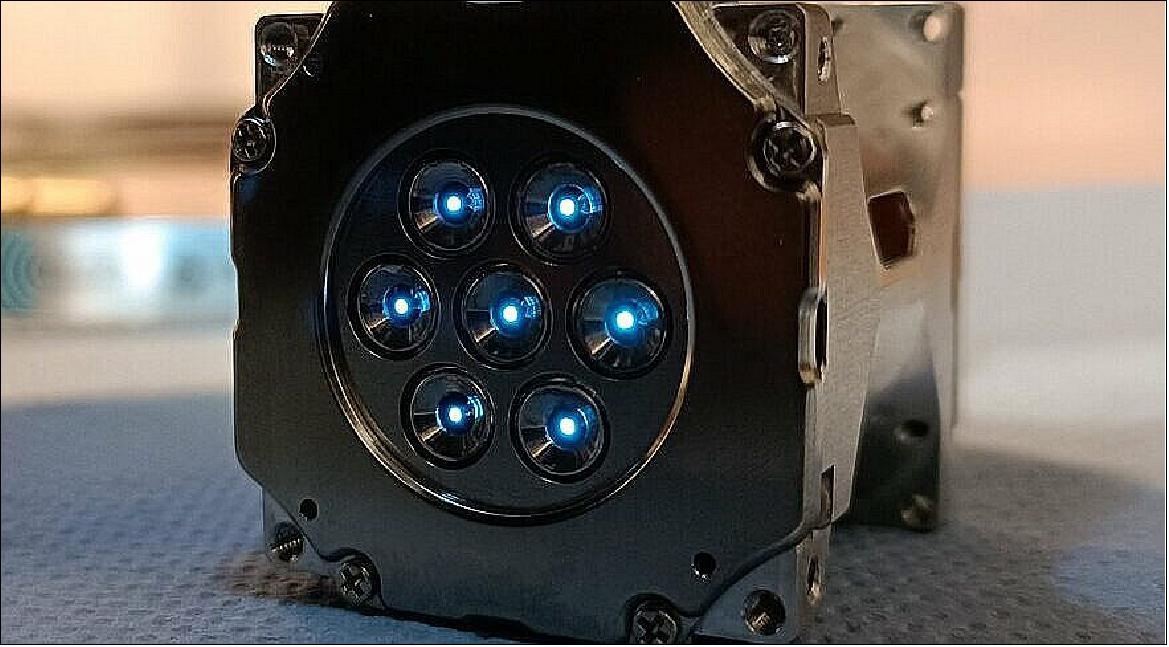
Morpheus attracted investment and high-profile backers in 2020 after proving that its Nano Field Effect Electric Propulsion or NanoFEEP thrusters, could propel CubeSats in orbit. Morpheus also sells MultiFEEP, a thruster that combines seven NanoFEEP thrusters with additional features for thrust vectoring.
Propulsion systems remain the core of Morpheus’ business, but rather than simply selling components, the company developed a line of products and services to simplify the task of selecting, paying for and using thrusters.
The products Morpheus announced 11 November 2021 are:
a) Sphere Go: MultiFEEP and NanoFEEP electric propulsion systems;
b) Sphere Direct: Plug-and-play, platform-agnostic autopilot;
c) Sphere Flow: Mission design software-as-a-service for constellations;
d) Sphere Safe: A hardware-as-a-service cost model for satellite components; and
e) Sphere Gateway: A web application to help guide customers from initial product exposure to satellite operations.
Morpheus’s new proprietary metal alloy propellant for MultiFEEP and NanoFEEP is non-toxic, non-corrosive, requires no special transportation or handling and is designed to provide satellites with continuous thrust for more than five years. Because few satellites in low Earth orbit need that much thrust, Morpheus has developed a cost model to ensure customers pay only $1,000 per propulsion module.
“This is the upfront cost,” said István Lörincz, Morpheus co-founder and president. “Then you can either pay on demand for usage of the propulsion system or you can go into the subscription model where you basically get a budget for propellant or movability for a certain time.”
Lörincz compares it to a mobile phone contract that provides a certain level of data throughput.
After extensive work to come up with the subscription model, Morpheus is inviting other satellite component manufacturers to adopt it as well.
“The upside here for our customers is the lower upfront costs and the shift in mentality,” Lörincz said. “Propulsion is not a feature or an extra. It’s something that has to contribute to the company’s bottom line, like ground stations. If you didn’t have ground stations, you wouldn’t be able to generate profits.”
Morpheus developed its Sphere ecosystem after meeting with satellite constellation developers to understand their needs.
“We saw that different constellation providers were doing similar things but with different approaches,” Lörincz said. “We wanted to take off that burden. We need more automation in this industry to make it more accessible to everyone.”
• July 6, 2021: IRT Saint Exupéry, Mbryonics, Morpheus Space, Oledcomm and R3-IoT were the winners of OneWeb’s 2021 Innovation Challenge, a campaign to designed to “rethink satellite connectivity” and establish new partnerships, according to London-based OneWeb. 6)

- OneWeb announced the winners July 1 during an online event tracking the launch of 36 broadband communications satellites on an Arianespace Soyuz rocket from Russia’s Vostochny Cosmodrome.
- The five Industrial Challenge winners “will now enter a co-engineering phase together with OneWeb to further develop their ideas,” OneWeb said in a July 7 news release.
- In addition to the industry winners, OneWeb named three Innovation Challenge winners in the academic and research category. Munich-based Fraunhofer, the overall winner in this category, will be invited to attend a future OneWeb launch on an Arianespace rocket. The two runners up, Imperial College London and Digantara, an Indian space technology company, will work with OneWeb on an unspecified research and development project.
- All the Innovation Challenge winners will have opportunities “to collaborate, grow and potentially secure a place in our global supply chain,” Massimiliano Ladovaz, OneWeb chief technology officer said in a statement. “We were blown away by the response to this challenge.” OneWeb “will continue to engage with many” Innovation Challenge participants, he added.
- OneWeb’s 2021 Innovation Challenge attracted more than 300 submissions from 19 countries in six weeks, Valery Gineste, OneWeb senior director of technologies, said during the broadcast. Companies and research organizations shared ideas ranging from sustainable materials and efficient propulsion to new satellite payloads and spaceflight safety improvements.
- OneWeb is building a 648-satellite global broadband constellation. With the July 1 launch, OneWeb’s constellation grew to include 256 satellites.
- When OneWeb announced the Innovation Challenge in April, it said firms would “compete in the Industrial Partners category to be part of co-engineering a new generation of satellite, with the opportunity to supply components for OneWeb’s constellation.”
- Winners alluded to their hopes for joining OneWeb’s supply chain when sharing news of their victories.
- “We will participate with R3 IoT Limited, Morpheus Space, Mbryonics and Oledcomm in the OneWeb adventure and will receive the opportunity to work on the OneWeb satellite program and drive the future of space communications,” France’s Institute of Technology Saint Exupéry.
- Mbyronics, based in Galway, Ireland, offered OneWeb optical terminals and photonics technology. “We greatly look forward to this opportunity of working with OneWeb on their mission to bridge the digital divide,” Mybronics’ posted July 1 on LinkedIn.
- In a news release, R3-IoT of Scotland said being named a OneWeb Industrial Partner validated its business model, technology and “the hard work and dedication of our talented team.”
- R3-IoT “can provide intelligent data solutions that extend beyond connectivity,” the news release added. “We aim to unlock new opportunities in key industrial sectors across the globe.”
Morpheus President Istvan Lörincz said the company was excited and humbled to have been selected from a huge pool of space companies.
- OneWeb never issued a list of 2021 Innovation Challenge competitors, but named 14 finalists including Curtiss-Wright, Fujitsu and Spire Global.
- Morpheus executives declined to say exactly what the firm shared with OneWeb through the Innovation Challenge. The company is known, however, for producing miniature electric thrusters for small satellites.
“Sustainability is at the heart of the company,” Morpheus CEO Daniel Bock told SpaceNews. “We’re also addressing the problem of space traffic control and managing all these different assets in space.”
- In addition to propulsion, Morpheus is offering customers “an entire ecosystem that will enable autonomous operation of constellations,” said David Kalinske, Morpheus chief revenue officer. “We are excited about providing the capability to satellite companies and spacecraft developers.”
- OneWeb’s fifth industrial Innovation Partner is Oledcomm, a French spinoff of Versailles University. Oledcomm advertises wireless communications called Light Fidelity or LiFi.
• August 26, 2020: Morpheus Space attracted a high-profile group of investors for its first venture capital round. 7)
- The German propulsion startup received investments from Germany’s Vsquared Ventures, Lavrock Ventures of MacLean, Virginia, Airbus Ventures of Menlo Park, California, In-Q-Tel, the venture capital arm of the U.S. intelligence community, Pallas Ventures and Techstars Ventures.
- Morpheus Space is not disclosing the amount of money raised, preferring instead to underscore the list of high-profile investors backing the firm.
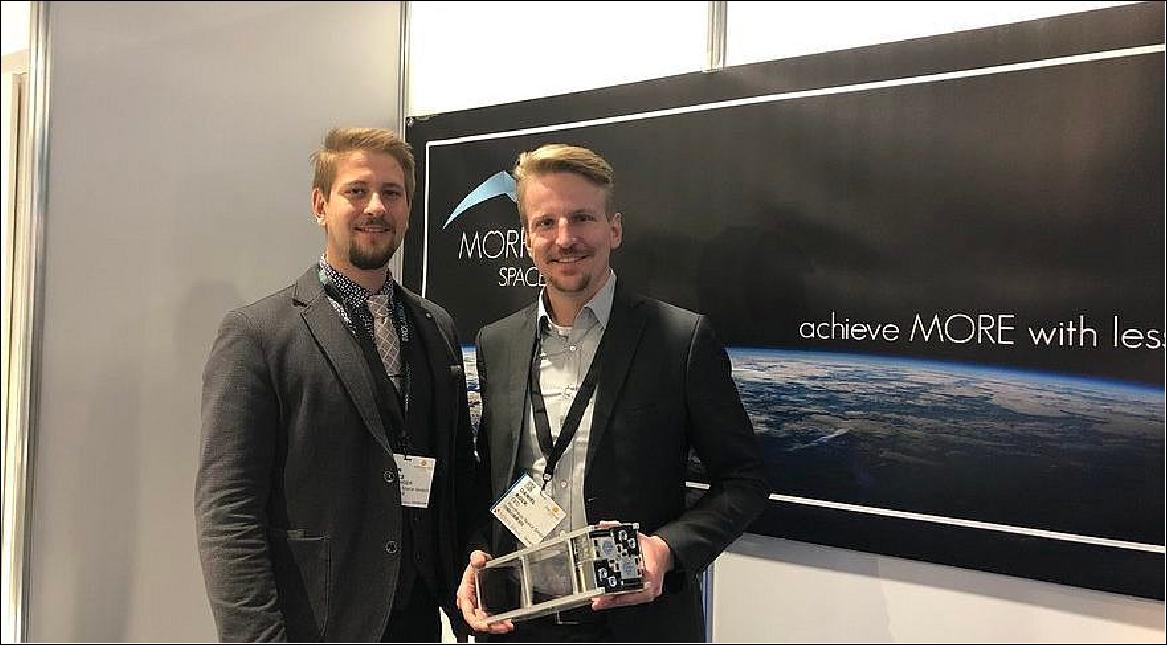
- “We are more than thrilled to have closed our funding round with an incredibly strong syndicate, especially in these difficult times,” Daniel Bock, Morpheus Space CEO and co-founder, said by email. “This is just the start to what I’m sure will be an exhilarating journey for us but also for the whole space industry.”
- Morpheus also announced Aug. 26 that former Navy Secretary Richard Spencer, now Pallas Ventures managing director, is joining the startup’s board of directors.
- “Morpheus has built an impressive capability and has the team to deliver for both public and private sector customers worldwide,” Spencer said in a statement.
- Morpheus Space manufactures Nano Field Effect Electric Propulsion or NanoFEEP thrusters, the type of thruster that propelled a German CubeSat, University of Würzburg Experimental-4, to a lower altitude in late June and early July. Bock was one of three inventors who patented the technology while at the Technical University of Dresden.
- “On-orbit maneuverability remains limited for many space systems, particularly for small spacecraft,” Richard French, Rocket Lab, space systems business development and strategy director, said in a statement. “Affordable, reliable and high-performance electric propulsion is a key ingredient for space systems designers desiring high impulse. Morpheus’ solution is a welcome addition to the supply chain and should impact both near Earth and deep space missions using small spacecraft.
- Morpheus was one of ten companies that participated in the first cohort of the Los Angeles-based Techstars Starburst Space Accelerator in 2019.
- “They’ve come so far since we invested in them last summer through the Techstars Starburst Space Accelerator,” said Matt Kozlov, Techstars Starburst Space Accelerator managing director.
- Herbert Mangesius, Vsquared Ventures founding partner, said in a statement, “Its electric propulsion system is a game-changer that enables many existing space applications and opens entirely new business opportunities ranging from ultra low Earth orbits to deep space exploration.”
- Steve Smoot, Lavrock Ventures, general partner, said in a statement, “Morpheus Space’s efficient, highly scalable propulsion system enables a host of new capabilities related to collision avoidance, deorbiting and constellation agility.”
- Claas Carsten Kohl, Airbus Ventures financial officer, said in a statement, “We’re pleased to support [Morpheus Space] in their mission of making impressively efficient space propulsion technologies globally available to providers of small satellites and constellations, further accelerating the growth of a vital new sector for private services in space.”
References
1) Hywel, ”Spotlight: Morpheus Space – Developing Ground-Breaking Electric Propulsion for Small Satellites,”Satsearch, 19 March 2019, URL: https://blog.satsearch.co/2019-03-19-member-spotlight-morpheus-space-developing-ground-breaking-electric-propulsion-for-small-satellites
2) Darrell Etherington, ”Morpheus Space’s modular, scalable satellite propulsion could be a game-changer for orbital industry,” 28 October 2019, URL: https://techcrunch.com/2019/10/28/
morpheus-spaces-modular-scalable-satellite-propulsion-could-be-a-game-changer-for-orbital-industry/
3) ”MORPHEUS: Cutting-edge spacecraft propulsion,” ESA Applications, 25 January 2019, URL: https://www.esa.int/Applications/Telecommunications_Integrated_Applications
/Technology_Transfer/MORPHEUS_Cutting-edge_spacecraft_propulsion
4) Karen Fox, ”NASA Awards Challenge Prizes to Startup Companies,” NASA Press Release 21-150, 12 November 2021, URL: https://www.nasa.gov/
press-release/nasa-awards-challenge-prizes-to-startup-companies
5) Debra Werner, ”Morpheus unveils Sphere product line for satellite constellations,” SpaceNews, 12 November 2021, URL: https://spacenews.com/morpheus-unveils-sphere-ecosystem/
6) Debra Werner, ”OneWeb names winners of 2021 Innovation Challenge,” SpaceNews, 6 July 2021, URL: https://spacenews.com/oneweb-2021-innovation-challenge-winners/
7) Debra Werner, ”Morpheus Space attracts high-profile backers,” SpaceNews, 26 August 2020, URL: https://spacenews.com/morpheus-space-attracts-high-profile-backers/
The information compiled and edited in this article was provided by Herbert J. Kramer from his documentation of: ”Observation of the Earth and Its Environment: Survey of Missions and Sensors” (Springer Verlag) as well as many other sources after the publication of the 4th edition in 2002. - Comments and corrections to this article are always welcome for further updates (eoportal@symbios.space).